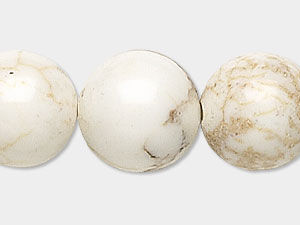Magnesite, White Meaning and Properties
White Magnesite History
Believed to be discovered in 1808, magnesite was named for its composition of mostly magnesium.
The most commonly occurring color of magnesite is white, with an appearance similar to unglazed porcelain. This variety of magnesite has long been valued for its ability to be carved. Native Americans, including the Pomo Tribes of California, carved white magnesite gemstones into beads for jewelry and currency. The currency beads were valued so highly they were traded individually versus by the strand like most other valued beads.
White Magnesite Metaphysical Properties
White magnesite is known for its calming properties, helping to improve creative visualization and imagination. It is also commonly believed to bring deep peace and silent relaxation during meditation, stimulate passion in the heart and help strengthen bones and teeth. White magnesite is said to open the heart chakra, bringing a sense of personal happiness and love for oneself, therefore increasing self-esteem.
White Magnesite Geological Properties
Magnesite ranges from translucent to opaque with variable amounts of carbonates, oxides, silicates of iron, calcium, manganese and aluminum that give it a milky appearance. Major deposits of white magnesite can be found in Austria, Italy, Poland and the state of Nevada.
Magnesite is a magnesium carbonate with the same crystal structure as calcite, a calcium carbonate with a hardness and texture similar to White Magnesite and marble. Magnesite forms when magnesium-rich rocks such as serpentine or dolomite are exposed to carbon dioxide-rich water.
Though typically white in color, magnesite ranges from yellow to white to grey in its natural form. The translucent to opaque stones can have a web-like pattern and a surprising fluorescing quality under shortwave UV lamps due to the high content of magnesium, which is how they are sometimes found in deep caves in Nevada. Magnesium-rich magnesite is even used as an element in the manufacture of Epsom salts and fireworks.
This stone can be enhanced through dyeing because of its good porosity. The dyed blue-green color makes it an economical simulation of turquoise.
|
|
|
|
|
|
|
|
|
|
|
|
|
|
|
|
|
|
Proper Care of White Magnesite
White magnesite is easily scratched, so special care should be taken in cleaning and storing this stone. Use water and a soft cloth to safely clean. Storing in a drawstring bag is a quick-and-easy way to protect the stone from scratches. It is not recommended to use ultrasonic and steam cleaning on dyed magnesite.
Designing with White Magnesite
Dyed white magnesite is an economical substitute for turquoise. It can be dyed vivid shades of turquoise blue, lime green or red with fantastic thick matrix patterns that texture the surface. Use large nuggets with antiqued sterling silver beads for a design with world cultural appeal.
Mix white magnesite with opal-colored crystal beads and glossy black onyx gemstone beads for high-impact designs. For a more classical approach, pair white magnesite with crystal golden shadow beads, finely faceted red garnet gemstone beads and bright gold "vermeil" filigree beads for designs of subtle luxury.
Shop for White Magnesite
**Please note that all metaphysical or healing properties listed are collected from various sources. This information is offered as a service and not meant to treat medical conditions. Fire Mountain Gems and Beads® does not guarantee the validity of any of these statements.
How did you like this resource? Your feedback helps us provide resources that matter to you most.
Copyright Permissions
All works of authorship (articles, videos, tutorials and other creative works) are from the Fire Mountain Gems and Beads® Collection, and permission to copy is granted for non-commercial educational purposes only. All other reproduction requires written permission. For more information, please email copyrightpermission@firemtn.com.

